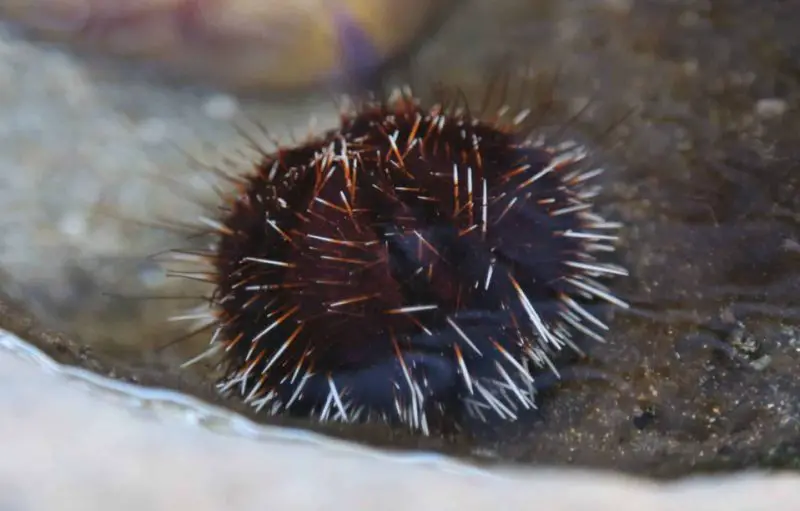At sunrise on the coast of Maui, the tide recedes, revealing a mosaic of coral, lava rock, and life. Beneath the shallow pools, spiny shapes cling to stone, their dark silhouettes catching the first glow of light. A closer look reveals movement — tiny spines waving, feeding, cleaning. These are sea urchins in Hawaii, the silent custodians of the Pacific reefs.
To the casual swimmer, sea urchins may seem like mere curiosities or painful hazards best avoided. But behind their armor of spines lies one of the ocean’s most fascinating and essential creatures. They shape the seafloor, sustain coral health, and embody a balance between creation and destruction that defines Hawaiian waters.
In this detailed guide, we uncover the hidden world of Hawaiian sea urchins — their biology, behavior, ecological importance, and cultural ties that stretch back centuries. The secrets of these humble creatures may change how you see Hawaii’s reefs forever.
Meet Hawaii’s Sea Urchins

Spiny Architects of the Reef
Sea urchins belong to the phylum Echinodermata, a group that includes starfish, sea cucumbers, and sand dollars. Their round, spiny bodies are built for defense and movement, powered by hundreds of tiny tube feet that function like suction cups.
There are over 15 species of sea urchins in Hawaii, each adapted to a unique habitat. Some live in coral reefs, others in tide pools, and a few burrow into lava rock along the coastline.
Among them, three species stand out for their ecological roles and visibility: the Collector Urchin (Tripneustes gratilla), the Slate Pencil Urchin (Heterocentrotus mammillatus), and the Rock-boring Urchin (Echinometra mathaei).
Together, they form a hidden workforce that shapes and maintains Hawaii’s underwater world.
Common Sea Urchins of Hawaii
-
Collector Urchin (Tripneustes gratilla) – Recognizable by its light spines and gentle appearance; a key algae grazer used in reef restoration.
-
Slate Pencil Urchin (Heterocentrotus mammillatus) – Thick red spines like chalk sticks; often seen on lava outcrops.
-
Rock-boring Urchin (Echinometra mathaei) – Small, dark purple, and found in tide pools and reef flats.
-
Long-spined Urchin (Diadema paucispinum) – Black and needle-thin spines that sway in the current, providing shelter for young fish.
-
Helmet Urchin (Colobocentrotus atratus) – Flattened, wave-resistant, and found on surf-battered rocks.
These diverse forms of sea urchins in Hawaii reflect adaptation at its finest — survival through specialization across the island chain’s varied marine habitats.
Anatomy of a Survivor
Life Behind the Spines
At first glance, sea urchins seem simple — little more than living pincushions. But beneath those spines lies an intricate system of organs designed for life in motionless balance.
Their shell, called a test, is made of interlocking calcium plates that protect the inner body. The mouth, located underneath, holds five teeth arranged in a structure known as “Aristotle’s lantern.” With this, urchins scrape algae from rocks, clean coral, and even carve out burrows.
Each spine attaches to a small joint that allows precise movement. Combined with tube feet, this gives Hawaiian sea urchins surprising agility — they can climb vertical surfaces, right themselves when flipped, and slowly glide across coral in search of food.
A 360° Sense of the World
Despite lacking eyes, sea urchins can detect light and shadows across their bodies. Thousands of light-sensitive cells embedded in their skin allow them to sense predators and movement from any direction.
When disturbed, they react almost instantly, pointing spines toward the threat or retreating into crevices. Their sensitivity is extraordinary — the ocean’s version of a living sensor array.
This remarkable adaptation has allowed sea urchins in Hawaii to thrive for millions of years, surviving storms, waves, and predators in one of the world’s most dynamic marine environments.
Life in the Hawaiian Reefs
The Role of Sea Urchins in Coral Health
Few ocean creatures play as vital a role in coral reef balance as sea urchins. They act as gardeners of the reef, grazing on algae that compete with corals for sunlight and space.
Without urchins, algae can overgrow and smother corals, turning vibrant reefs into dull, lifeless plains. When Collector Urchins were reintroduced to some degraded reefs in Oahu, scientists recorded dramatic improvements — clearer water, reduced algal cover, and new coral growth.
In essence, sea urchins in Hawaii are coral custodians, quietly restoring the ecosystem one bite at a time.
Reef Cleaners and Engineers
Beyond controlling algae, sea urchins shape their environment through excavation and bioerosion. As they feed and burrow, they wear away rock surfaces, creating microhabitats for worms, snails, and small fish.
These small changes ripple through the ecosystem, enhancing biodiversity. A single patch of reef may host dozens of tiny species thanks to the feeding patterns of a few dozen urchins.
Their spines also offer refuge for juvenile fish and shrimp — a living fortress of protection in the open reef.
In Hawaiian waters, the humble urchin is both engineer and guardian, maintaining the delicate structure of life below the waves.
Behavior and Adaptation
Nighttime Wanderers
Most Hawaiian sea urchins are nocturnal. As darkness falls, they emerge from cracks and holes to graze. During the day, they remain hidden, avoiding fish and octopus predators.
This rhythm ensures they play their role in reef maintenance without drawing attention. At night, the reef becomes a moving carpet of spines, feeding quietly under moonlight — a sight few divers forget.
Their daily migration between shade and open water demonstrates not only survival instincts but also ecological timing perfectly tuned to Hawaii’s marine cycle.
Defense Through Design
The urchin’s best defense is its shape. Spherical symmetry allows spines to face any direction, creating a nearly impenetrable shield.
Some species, like the Slate Pencil Urchin, rely on thick, blunt spines that deter predators, while others, such as the Long-spined Urchin, use flexible, needle-like spines to create a living barrier.
Even broken spines regenerate — a natural recycling system that keeps them perpetually ready for defense.
It’s no wonder sea urchins in Hawaii have survived across millennia, unchanged in form yet crucial in function.
Feeding and Diet
The Algae Grazer’s Role
The diet of most Hawaiian sea urchins consists primarily of algae, coraline films, and detritus. Their strong teeth allow them to scrape microscopic algae from stone or coral, keeping reef surfaces clean.
This grazing prevents algal blooms and supports coral larvae settlement — a process crucial for reef recovery after bleaching or storms.
In some regions, such as Kaneohe Bay, the introduction of thousands of Collector Urchins has transformed algal-choked reefs into thriving coral communities, proving their ecological power.
Occasional Carnivores
Though primarily herbivorous, sea urchins are opportunistic. They sometimes feed on sponges, dead fish, or organic debris. This adaptability allows them to survive in nutrient-poor waters where algae alone might not suffice.
Such flexibility also enables sea urchins in Hawaii to persist in dynamic coastal environments, from calm lagoons to surf-pounded lava shelves.
They are, in essence, nature’s recyclers — converting waste and algae into energy that fuels the reef’s food chain.
Reproduction and Life Cycle
Spawning Under the Moon
Most sea urchins reproduce by external fertilization. Males and females release eggs and sperm into the water simultaneously, often triggered by lunar cycles and temperature changes.
In Hawaii, this typically happens during spring and summer months when plankton levels rise. The ocean fills with invisible clouds of life, drifting and mixing under moonlit waves.
After fertilization, larvae float for weeks as part of the plankton before settling onto hard surfaces. From there, a new generation of sea urchins in Hawaii begins life among coral rubble or tide pools — small, vulnerable, and endlessly hungry.
The Journey to Adulthood
Growth is slow but steady. Juvenile urchins develop spines within days and begin grazing as soon as they can cling to rocks. Over several years, they reach maturity, contributing to the reef’s stability and nutrient cycles.
With lifespans often exceeding 20 years, an adult urchin may witness entire coral generations rise and fall — a living thread through time on Hawaii’s reefs.
Their quiet endurance mirrors the patience of the ocean itself.
Cultural Significance in Hawaii
Sea Urchins in Hawaiian Tradition
To Native Hawaiians, sea urchins, or wana, hold both practical and spiritual meaning. The spines of some species were used as tools, while the tests (shells) became ornaments or offerings.
Urchin roe, known as uni, was historically eaten in small quantities, appreciated for its rich, briny flavor — a delicacy tied to respect for the ocean’s abundance.
Spiritually, the wana symbolized protection and perseverance, reflecting the belief that strength lies not in aggression but in resilience.
Even today, divers and fishermen in Hawaii view sea urchins with a mix of caution and reverence — aware of their sting but grateful for their role in keeping reefs alive.
Modern Importance and Research
In recent years, sea urchins in Hawaii have gained new importance as tools in reef restoration. The state’s Division of Aquatic Resources cultivates Collector Urchins in hatcheries, releasing them into algae-dominated reefs to restore balance.
These programs have become models of ecological recovery, demonstrating how nature’s smallest workers can heal environments disrupted by human activity.
What began as cultural respect has evolved into scientific collaboration — the fusion of traditional wisdom and modern conservation.
Threats and Conservation
Challenges Facing Hawaiian Sea Urchins
Despite their resilience, urchins face growing threats. Pollution, overfishing of predators, and coral bleaching all disrupt the delicate balance they maintain.
Excessive algae growth — often caused by nutrient runoff — can suffocate reefs faster than urchins can clean them. Ironically, in some areas, too many urchins can cause damage by overgrazing young coral.
Finding equilibrium is key. Scientists now monitor sea urchins in Hawaii to ensure populations remain stable — enough to protect reefs, but not enough to harm them.
The Future of Hawaii’s Reefs
With ocean temperatures rising and coral bleaching events increasing, sea urchins will play an even greater role in the future of Hawaii’s marine ecosystems.
Their simple yet vital task — grazing algae — may determine whether coral reefs recover or collapse. In that sense, the fate of Hawaii’s underwater paradise rests partly in the spiny hands of these unassuming creatures.
Protecting them means protecting the reef — and ultimately, the islands themselves.
Surprising and Little-Known Facts About Sea Urchins in Hawaii
-
Some Hawaiian sea urchins can survive being overturned by waves that would crush most marine life.
-
Their teeth never stop growing — constantly regenerating as they wear down.
-
Sea urchin roe (uni) is a delicacy in Hawaiian and Japanese cuisine.
-
The Helmet Urchin is shaped like a dome to withstand the pounding surf.
-
Urchins move faster than they appear — up to 12 inches per minute.
-
Their spines are covered in tiny cilia that sweep debris away like brushes.
-
The color of an urchin’s spines often reflects the minerals in its habitat.
-
Urchins play a crucial role in reef carbon cycling, aiding coral growth indirectly.
-
Ancient Hawaiians used urchin spines as needles and fish hooks.
-
Some sea urchins in Hawaii host small crabs and shrimp that live among their spines for protection.
FAQs About Sea Urchins in Hawaii
Are sea urchins dangerous to humans?
Most are harmless, but stepping on a sea urchin in Hawaii can cause painful punctures. Avoid handling them with bare hands.
What should I do if I step on one?
Remove visible spines carefully, soak in hot water to neutralize toxins, and seek medical care for deep wounds.
Are all sea urchins in Hawaii native?
No. Some introduced species exist, but native urchins dominate coral and rocky reef habitats.
What do sea urchins eat?
They feed primarily on algae, coraline crusts, and organic detritus.
Are sea urchins good for coral reefs?
Yes, in balanced numbers they prevent algae from overtaking corals, helping reefs stay healthy.
Can sea urchins be eaten?
Yes. Their roe (uni) is edible and prized, though collecting them in Hawaii requires specific permits.
How long do sea urchins live?
Many species live 15–30 years, depending on habitat and predation.
Where can I see sea urchins in Hawaii?
In tide pools, coral reefs, and lava shores across Maui, Oahu, and the Big Island — especially at low tide.
Are sea urchins used in conservation?
Yes. Hatchery-grown Collector Urchins are released into reefs to control algae and restore coral health.
Why are sea urchins important to Hawaii’s ecology?
They regulate algal growth, recycle nutrients, and provide shelter for small marine species, maintaining reef balance.
Final Thoughts
The sea urchins of Hawaii are living symbols of balance — creatures that sculpt, clean, and protect the ocean’s foundations. Their spines, once feared, are shields not just for survival but for the life of entire reefs.
From ancient Hawaiian traditions to modern conservation, their story bridges time and science. They remind us that even the smallest beings hold immense power in shaping the world around them.
The truth about sea urchins in Hawaii is this: they are not just spiny ornaments of the sea but the quiet engineers of its beauty, resilience, and future.






